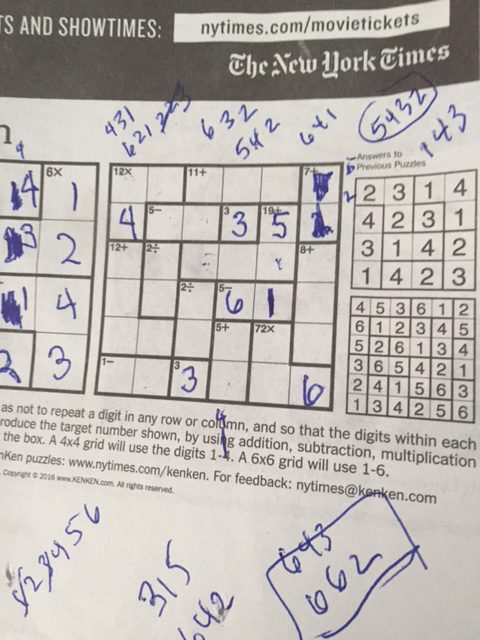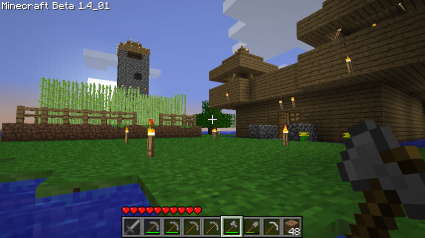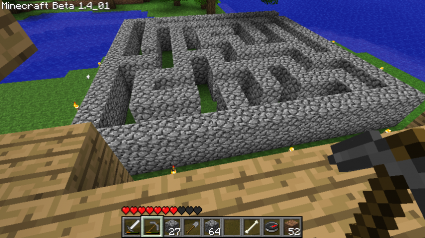The other day I mentioned that generating random Latin squares was a bit more complicated than I thought, and that an algorithm by Jacobson and Matthews was the way that people typically did it. I worked up this implementation based on a couple of different descriptions of the algorithm (the original paper was behind a paywall). The code below simply generates a random DIMxDIM Latin square using their algorithm. I haven’t done extensive testing, but it appears to mostly work. I did run a test where I generated one million 4×4 matrices, and found that it generated all 576 different matrices in approximately the same propertion, so it appears to at least be roughly operational. I’ll eventually merge the code with my nascent KenKen generator.
[sourcecode lang=”cpp”]
#include <stdio.h>
#include <stdlib.h>
#include <unistd.h>
/*
* rls.c
*
* A straightforward implementation of the algorithm by Jacobson and
* Matthews, _Generating uniformly distributed random Latin square_,
* Journal of Combinatorial Design, 1996.
*
* I actually couldn’t find the original paper, so this is an implementation
* based upon other descriptions of the algorithm.
*
* Written by Mark VandeWettering.
*
*/
#define DIM (6)
typedef struct t_incidence_cube {
int s[DIM][DIM][DIM] ;
} IncidenceCube ;
void
InitIncidenceCube(IncidenceCube *c)
{
int i, j, k ;
/* First, zero the cube */
for (i=0; i<DIM; i++)
for (j=0; j<DIM; j++)
for (k=0; k<DIM; k++)
c->s[i][j][k] = 0 ;
/* And then dump ones in the right place… */
for (i=0; i<DIM; i++)
for (j=0; j<DIM; j++)
c->s[i][j][(i+j)%DIM] = 1 ;
}
void
PrintIncidenceCube(IncidenceCube *c)
{
int i, j, k ;
for (i=0; i<DIM; i++) {
for (j=0; j<DIM; j++) {
for (k=0; k<DIM; k++) {
if (c->s[i][j][k]) {
printf("%2d ", k+1) ;
break ;
}
}
}
printf("\n") ;
}
printf("\n") ;
}
void
CompactPrintIncidenceCube(IncidenceCube *c)
{
int i, j, k ;
for (i=0; i<DIM; i++) {
for (j=0; j<DIM; j++) {
for (k=0; k<DIM; k++) {
if (c->s[i][j][k]) {
printf("%01d", k+1) ;
break ;
}
}
}
}
printf("\n") ;
}
void
ShuffleIncidenceCube(IncidenceCube *c)
{
int i, j ;
for (i=0; i<DIM*DIM*DIM; i++) {
// Assume we have a "proper" matrix…
// Pick a random zero from the incidence cube…
int rx, ry, rz ;
do {
rx = lrand48() % DIM ;
ry = lrand48() % DIM ;
rz = lrand48() % DIM ;
} while (c->s[rx][ry][rz]) ;
int ox, oy, oz ;
for (j=0; j<DIM; j++) {
if (c->s[j][ry][rz] == 1)
ox = j ;
if (c->s[rx][j][rz] == 1)
oy = j ;
if (c->s[rx][ry][j] == 1)
oz = j ;
}
// do the +/- 1 move…
// These are all square with zeros in them…
c->s[rx][ry][rz] ++ ;
c->s[rx][oy][oz] ++ ;
c->s[ox][ry][oz] ++ ;
c->s[ox][oy][rz] ++ ;
// These all have ones, except for maybe the last one…
c->s[rx][ry][oz] — ;
c->s[rx][oy][rz] — ;
c->s[ox][ry][rz] — ;
c->s[ox][oy][oz] — ;
while (c->s[ox][oy][oz] < 0) {
rx = ox ;
ry = oy ;
rz = oz ;
// Pick one of the two 1’s that are in conflict
if (drand48() < 0.5) {
for (j=0; j<DIM; j++) {
if (c->s[j][ry][rz] == 1) {
ox = j ;
}
}
} else {
for (j=DIM-1; j>=0; j–) {
if (c->s[j][ry][rz] == 1) {
ox = j ;
}
}
}
if (drand48() < 0.5) {
for (j=0; j<DIM; j++) {
if (c->s[rx][j][rz] == 1) {
oy = j ;
}
}
} else {
for (j=DIM-1; j>=0; j–) {
if (c->s[rx][j][rz] == 1) {
oy = j ;
}
}
}
if (drand48() < 0.5) {
for (j=0; j<DIM; j++) {
if (c->s[rx][ry][j] == 1) {
oz = j ;
}
}
} else {
for (j=DIM-1; j>=0; j–) {
if (c->s[rx][ry][j] == 1) {
oz = j ;
}
}
}
// do the +/- 1 move…
// These are all square with zeros in them…
c->s[rx][ry][rz] ++ ;
c->s[rx][oy][oz] ++ ;
c->s[ox][ry][oz] ++ ;
c->s[ox][oy][rz] ++ ;
// These all have ones, except for maybe the last one…
c->s[rx][ry][oz] — ;
c->s[rx][oy][rz] — ;
c->s[ox][ry][rz] — ;
c->s[ox][oy][oz] — ;
}
}
}
int
main()
{
IncidenceCube c ;
int i ;
srand48(getpid()) ;
InitIncidenceCube(&c) ;
ShuffleIncidenceCube(&c) ;
PrintIncidenceCube(&c) ;
return 1 ;
}
[/sourcecode]




